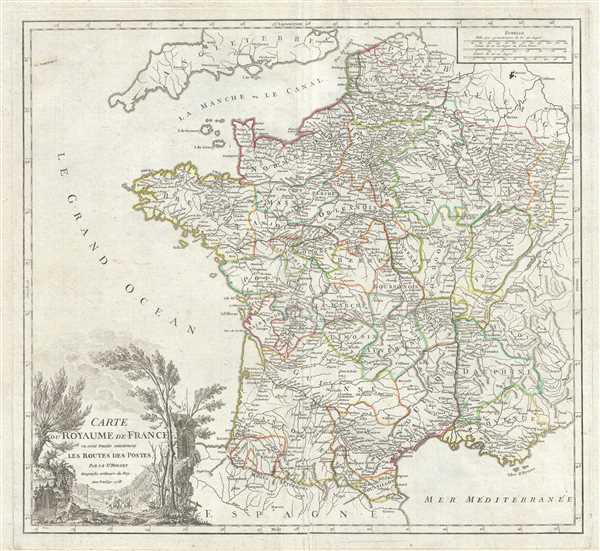1758 Vaugondy Map of France w/ Postal Routes
RoyaumeDeFrancePostes-vaugondy-1757
Title
1758 (dated) 19.5 x 21.5 in (49.53 x 54.61 cm) 1 : 2400000
Description
Historically, France at this time was under the reign of Louis XVI, the last Ancien Regime French King before the French Revolution. Louis XVI was probably not the worse king France ever had, but he was definitely in the wrong place at the wrong time. In the years just prior to the 1889 French Revolution, France had entered a period of sustained economic decline. French involvement in the American Revolutionary War and the Seven Years War strained the national treasury and put increased pressure on the peasantry. This was compounded by several years of poor harvest brought on by erratic weather patterns associated with el Nino and the 1783 eruptions of the Icelandic Laki and Grimsvotn volcanoes. The Royal court at Versailles, isolated and seemingly indifferent to the hardships of the lower classes, proved an easy target. Events came to a head on July 14th, 1789, when angry insurgents stormed the Bastille prison, giving birth to the bloody French Revolution and effectively ending the French monarchy.
The map includes a beautifully engraved title cartouche in the top left quadrant. This map was drawn by Robert de Vaugondy and published in the 1757 issue of his Atlas Universal.
Cartographer
Robert de Vaugondy (fl. c. 1716 - 1786) was French may publishing from run by brothers Gilles (1688 - 1766) and Didier (c. 1723 - 1786) Robert de Vaugondy. They were map publishers, engravers, and cartographers active in Paris during the mid-18th century. The father and son team were the inheritors to the important Nicolas Sanson (1600 - 1667) cartographic firm whose stock supplied much of their initial material. Graduating from Sanson's maps, Gilles, and more particularly Didier, began to produce their own substantial corpus. The Vaugondys were well-respected for the detail and accuracy of their maps, for which they capitalized on the resources of 18th-century Paris to compile the most accurate and fantasy-free maps possible. The Vaugondys compiled each map based on their own geographic knowledge, scholarly research, journals of contemporary explorers and missionaries, and direct astronomical observation. Moreover, unlike many cartographers of this period, they took pains to reference their sources. Nevertheless, even in 18th-century Paris, geographical knowledge was limited - especially regarding those unexplored portions of the world, including the poles, the Pacific Northwest of America, and the interiors of Africa, Australia, and South America. In these areas, the Vaugondys, like their rivals De L'Isle and Buache, must be considered speculative or positivist geographers. Speculative geography was a genre of mapmaking that evolved in Europe, particularly Paris, in the middle to late 18th century. Cartographers in this genre would fill in unknown lands with theories based on their knowledge of cartography, personal geographical theories, and often dubious primary source material gathered by explorers. This approach, which attempted to use the known to validate the unknown, naturally engendered rivalries. Vaugondy's feuds with other cartographers, most specifically Phillipe Buache, resulted in numerous conflicting papers presented before the Academie des Sciences, of which both were members. The era of speculative cartography effectively ended with the late 18th-century explorations of Captain Cook, Jean Francois de Galaup de La Perouse, and George Vancouver. After Didier died, his maps were acquired by Jean-Baptiste Fortin, who in 1787 sold them to Charles-François Delamarche (1740 - 1817). While Delamarche prospered from the Vaugondy maps, he defrauded Vaugondy's window Marie Louise Rosalie Dangy of her rightful inheritance and may even have killed her. More by this mapmaker...

